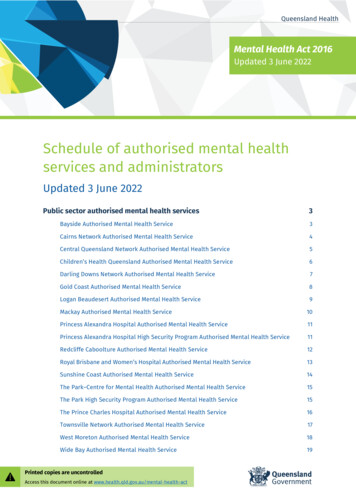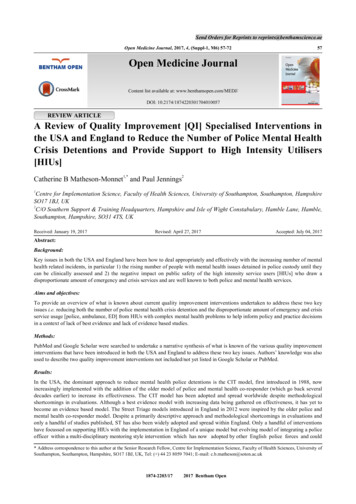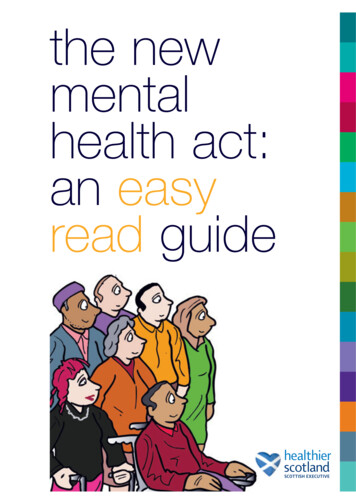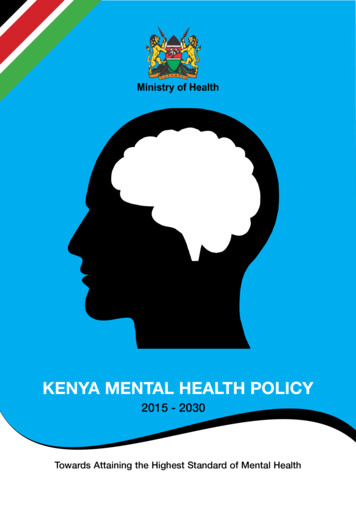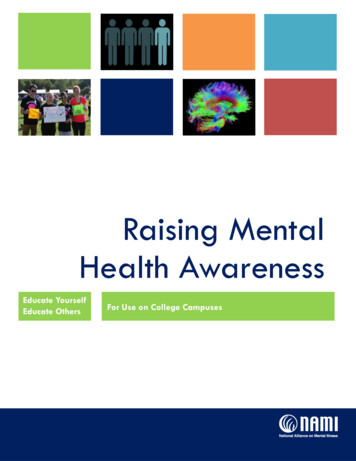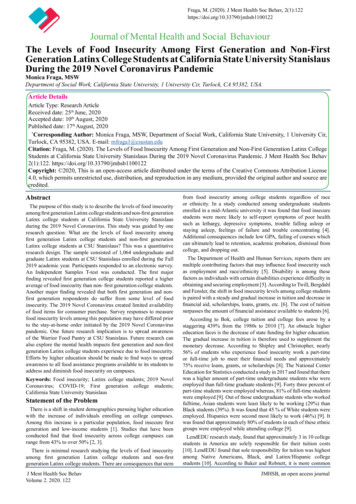
Transcription
Fraga, M. (2020). J Ment Health Soc Behav, al of Mental Health and Social BehaviourThe Levels of Food Insecurity Among First Generation and Non-FirstGeneration Latinx College Students at California State University StanislausDuring the 2019 Novel Coronavirus PandemicMonica Fraga, MSWDepartment of Social Work, California State University, 1 University Cir, Turlock, CA 95382, USA.Article DetailsArticle Type: Research ArticleReceived date: 25th June, 2020Accepted date: 10th August, 2020Published date: 17th August, 2020*Corresponding Author: Monica Fraga, MSW, Department of Social Work, California State University, 1 University Cir,Turlock, CA 95382, USA. E-mail: mfraga1@csustan.eduCitation: Fraga, M. (2020). The Levels of Food Insecurity Among First Generation and Non-First Generation Latinx CollegeStudents at California State University Stanislaus During the 2019 Novel Coronavirus Pandemic. J Ment Health Soc Behav2(1):122. https://doi.org/10.33790/jmhsb1100122Copyright: 2020, This is an open-access article distributed under the terms of the Creative Commons Attribution License4.0, which permits unrestricted use, distribution, and reproduction in any medium, provided the original author and source arecredited.AbstractThe purpose of this study is to describe the levels of food insecurityamong first generation Latinx college students and non-first generationLatinx college students at California State University Stanislausduring the 2019 Novel Coronavirus. This study was guided by oneresearch question: What are the levels of food insecurity amongfirst generation Latinx college students and non-first generationLatinx college students at CSU Stanislaus? This was a quantitativeresearch design. The sample consisted of 1,064 undergraduate andgraduate Latinx students at CSU Stanislaus enrolled during the Fall2019 academic year. Participants responded to an electronic survey.An Independent Samples T-test was conducted. The first majorfinding revealed first generation college students reported a higheraverage of food insecurity than non- first generation college students.Another major finding revealed that both first generation and nonfirst generation respondents do suffer from some level of foodinsecurity. The 2019 Novel Coronavirus created limited availabilityof food items for consumer purchase. Survey responses to measurefood insecurity levels among this population may have differed priorto the stay-at-home order initiated by the 2019 Novel Coronaviruspandemic. One future research implication is to spread awarenessof the Warrior Food Pantry at CSU Stanislaus. Future research canalso explore the mental health impacts first generation and non-firstgeneration Latinx college students experience due to food insecurity.Efforts by higher education should be made to find ways to spreadawareness to all food assistance programs available to its students toaddress and diminish food insecurity on campuses.Keywords: Food insecurity; Latinx college students; 2019 NovelCoronavirus; COVID-19; First generation college students;California State University StanislausStatement of the ProblemThere is a shift in student demographics pursuing higher educationwith the increase of individuals enrolling on college campuses.Among this increase is a particular population, food insecure firstgeneration and low-income students [1]. Studies that have beenconducted find that food insecurity across college campuses canrange from 43% to over 50% [2, 3].There is minimal research studying the levels of food insecurityamong first generation Latinx college students and non-firstgeneration Latinx college students. There are consequences that stemJ Ment Health Soc BehavVolume 2. 2020. 122from food insecurity among college students regardless of raceor ethnicity. In a study conducted among undergraduate studentsenrolled in a mid-Atlantic university it was found that food insecurestudents were more likely to self-report symptoms of poor healthsuch as lethargy, depressive symptoms, trouble falling asleep orstaying asleep, feelings of failure and trouble concentrating [4].Additional consequences include low GPA, failing of courses whichcan ultimately lead to retention, academic probation, dismissal fromcollege, and dropping out.The Department of Health and Human Services, reports there aremultiple contributing factors that may influence food insecurity suchas employment and race/ethnicity [5]. Disability is among thesefactors as individuals with certain disabilities experience difficulty inobtaining and securing employment [5]. According to Twill, Bergdahland Fensler, the shift in food insecurity levels among college studentsis paired with a steady and gradual increase in tuition and decrease infinancial aid, scholarships, loans, grants, etc. [6]. The cost of tuitionsurpasses the amount of financial assistance available to students [6].According to Bok, college tuition and college fees arose by astaggering 439% from the 1980s to 2010 [7]. An obstacle highereducation faces is the decrease of state funding for higher education.The gradual increase in tuition is therefore used to supplement themonetary decrease. According to Shipley and Christopher, nearly56% of students who experience food insecurity work a part-timeor full-time job to meet their financial needs and approximately75% receive loans, grants, or scholarships [8]. The National CenterEducation for Statistics conducted a study in 2017 and found that therewas a higher amount of part-time undergraduate students who wereemployed than full-time graduate students [9]. Forty three percent ofpart-time students were employed whereas, 81% of full-time studentswere employed [9]. Out of those undergraduate students who workedfulltime, Asian students were least likely to be working (29%) thanBlack students (39%). It was found that 45 % of White students wereemployed. Hispanics were second most likely to work (46%) [9]. Itwas found that approximately 80% of students in each of these ethnicgroups were employed while attending college [9].LendEDU research study, found that approximately 3 in 10 collegestudents in America are solely responsible for their tuition costs[10]. LendEDU found that sole responsibility for tuition was highestamong Native Americans, Black, and Latinx/Hispanic collegestudents [10]. According to Baker and Robnett, it is more commonJMHSB, an open access journal
Page 2 of 12for Latinx and Black students to come from a lower socio-economicstanding when compared to Asian American students and Whitestudents [11]. It is also more common for Latino and Black studentsto carry much of the financial burden of college expenses. This maylead students to obtain employment in order to support themselveswhile attending school which can interfere in the student’sparticipation in their academics [11]. According to Kolowich, therehas been an increase of food insecurity among college studentsenrolling in higher education [1]. The United States Department ofAgriculture defines food insecurity as, “consistent access to adequatefood limited by a lack of money and other resources at times duringthe year” [12].According to psychologist Abraham Maslow, one of the most basicneeds of human physical survival is food [13]. Without food, humanscannot function at their optimal level [13]. In order to achieveself-actualization, humans must have their physiological needsmet, along with safety needs, loving and belongingness needs, andesteem needs [13]. Based on Maslow’s Hierarchy of Needs theory,students who lack these categories of needs, will not excel at theirfull potential [13]. Students who do not have adequate food, will besolely motivated to fulfill their primary physiological needs, such ashunger. The motivation to exemplify their academic capabilities willnot be a priority for students who suffer from food insecurity.Although the research is sparse, there is enough research thatprompted some campuses to action. There have been initiativesenacted at colleges and universities by administration to support thestudents who experience food insecurity. Michigan State Universitywas the first college campus nationwide to establish a food programin 1993 for its students [14]. It was not until 2015 that CaliforniaState University Chancellor, Timothy White, commissioned aresearch study to raise awareness for the needs of food insecure anddisplaced students [15]. This study found that approximately 21%of students reported food insecurity. The findings of this study ledto the creation of the CSU Basic Needs Initiative [15]. Universityof California Office of the President, the body that oversees all UCs,launched a Global Food Initiative in 2014 [16]. This initiative hasbeen responsible for the implementation and expansion of foodpantry services [16].Statement of PurposeThe purpose of this study is to describe the levels of food insecurityamong first generation Latinx college students and non-firstgeneration Latinx college students at CSU Stanislaus. This researchstudy utilized a type of quantitative research known as descriptiveresearch. The study was guided by one question: What are the levelsof food insecurity among first generation Latinx college students atCSU Stanislaus and non-first generation Latinx college students atCSU Stanislaus?The researcher hypothesized that first generation Latinx collegestudents experience a higher level of food insecurity than non-firstgeneration Latinx college students.Significance of the StudyThe results of the study are made public and used to raise awarenesssurrounding food insecurity levels among Latinx students attendingCSU Stanislaus. A research study that seeks to discover if there isdifference in food insecurity levels among first generation Latinxcollege students and non-first generation Latinx college studentsat CSU Stanislaus has not been conducted. If the data finds thereis a higher level of food insecurity among first generation Latinxcollege students, this can prompt additional studies, such as studyingfood insecurity levels and its impact on mental health among firstgeneration Latinx college students or non-first generation Latinxcollege students. It is hopeful more campus administrators willbecome aware of the magnitude of this problem so they will takeproactive measures to create committees on campus or expand existingJ Ment Health Soc BehavVolume 2. 2020. 122food programs to assist fellow students who suffer from foodinsecurity. In bringing awareness to this issue it is hopeful that studiessuch as this one will help to create more opportunities for collegecampuses to receive grants and funds that will be used toward foodprograms for students.Students attending higher education institutions come from variousbackgrounds and various socio-economic levels [17]. Students whocome from vulnerable backgrounds are more likely to struggle withfood insecurity [17]. As social workers, one of our responsibilitiesis to “challenge inequities” [18]. The disproportionality of restrictedstudent access to the basic human need, food, is an injustice tostudents enrolled in higher education. Not only bringing awarenessto this issue, but also advocating for students and taking action todecrease food insecurity challenges is a movement toward achievingequity on college campuses. It is time to magnify the severity of thesituation to promote open dialogues within campuses to help othersbetter understand the depth of the problem and create solutions.Literature ReviewThis chapter aims to describe the existing knowledge regardingfood insecurity among Latinx college students. It exploresTranspersonal and Conflict theory, describes key concepts, such asthe origin of the letter “X” and its symbolism. It will define Latinx,first generation, and food insecurity. In addition, this chapter willreview food insecurity research studies completed at minorityserving institutions. Lastly, this chapter explores various policies,programs and pantries that have been implemented to alleviate foodinsecurity among college campuses across the nation. This chapterwill first provide readers with a broader understanding of how theoryconcepts can help understand why food insecurity exists and why itis important for individuals to be food secure.Transpersonal TheoryIn the late 1960s, after Maslow introduced his hierarchy of needsmodel, the 6th tier, transcendence needs was added to the hierarchy[19]. Transcendence is known to be the highest level of being [19].Once self-transcendence has been reached, one has reached theirown full personal potential. This level cannot be reached unless basicneeds, such as food and shelter, are met [19]. Psychological needs,safety needs, love needs, esteem needs and self-actualization must bemet and surpassed to reach transcendence [19].According to Maslow, a person who has reached self-transcendenceaims for a cause that is beyond their own personal benefit [20]. Manypeople who reach self-transcendence will immerse themselves intoaltruistic activities [20]. This notion is important in that for studentsto reach self-transcendence and have the ability to support others intheir community or beyond, it is vital each of Maslow’s tiers mustbe met. Individuals who have reached self-transcendence can viewthe world on a macro scale independent of their own boundaries.According to Maslow, those who reach this last tier in the hierarchyof needs, are individuals he categorized as healthy and fullydeveloped [20]. Self-transcended individuals have the ability toconceptualize their own purpose and meaning of life outside of theirown environment [20]. For transcendence to be met, students musthave their basic needs met first.Conflict TheoryKarl Marx’s conflict theory suggests conflict arises when resourcesare limited and not distributed equally. According to Marx, “Socialtheory should focus on how people influence and are influenced bytheir material conditions; for example, their degree of hunger ”[21]. According to Marx, humans’ primary necessities are eating,shelter, drinking, and clothing [22]. Dominant groups have means ofeasily obtaining basic needs, such as, food. Vulnerable subordinategroups struggle to fight oppressive systems and injustices to remainor be food secure. Due to lack of unemployment and amount ofincome people earn, individuals fall within the lower end of theJMHSB, an open access journal
Page 3 of 12socio-economic ladder in society [22]. One group of individualsthat can be classified in this category are college students. Society isstructured in a way where those who control the means of productionoppress those of the subordinate class [23]. Research has shownthis power disparity can negatively impact people’s lives [24.] Oneexample of how oppressed individuals regain power is through theuse of symbolism.Symbolism of “X”Historically, the letter X, in terms of a name, represents a severance,a liberation, a rejection of a last name and used as a recognizedsignature for those who are illiterate or suffer from a disability thatprevents them from signing their name. In addition, the letter X hasreligious connotations in the Muslim religion [25]. In the Muslimreligion, many black Muslims such as Civil Rights Movement leader,Malcom X, adopted X in place of their former slave name [25]. It wasbetween the 1950s and 1970s when those who followed the Islamicreligion also adopted the letter X in place of their last name [26].X has been used to replace a slave master’s last name that was givento African Americans centuries prior. X symbolized the unknownAfrican name of ancestors who were owned by slaves [27]. Thelast name that has been passed on from generation to generation offormer slaves is reminder of the horrific history, racism, oppression,pain and suffering slaves have endured.Typically, an X has also been used in place of a signature byindividuals who were disabled or illiterate. Signing a document withan X can carry stigma associated with a disability or illiteracy. Thishas been viewed negatively upon the signing individual, such as,lacking little to no education [28].LatinxAlthough the term Latinx has gained attention among activists andin academia, there is an inconsistency surrounding when this termwas first used [29]. The term Latinx has been used by various activistgroups since the beginning of the early 2000s [29]. It was created as agender-inclusive and gender-free term, whereas Latino distinguishesmasculinity due to the “o” in Spanish; and Latina which distinguishesfemininity due to the “a” in the Spanish language [29]. As the X wasused to replace a slave owners last name, the letter X has been usedin Latinx as a non-gender identifying replacement [29].The background of these terms can be complex in that each personmay choose how they want to be identified, although the governmentsocially constructs race and ethnicity to identify individuals in acertain category. Latinx is a person who descends from or was bornin a Latin American country such as Mexico, Colombia, El Salvador,etc. [29]. Latinx does not include a person who was born or descendsfrom Spain [29]. Latinx is sometimes used interchangeably withHispanic, however, Hispanic refers to linguistics rather than culture.Hispanic is term used for persons who descend from a Spanishspeaking country such as Honduras, Spain, Mexico, etc. [30]. Latinxstudents make up 61% of first generation college students [31].First GenerationA first generation college student is defined as a student whoseparents have not acquired a college degree [32]. A large percentageof first generation college students come from low socio-economicbackgrounds [33]. It is common for first generation college studentsto struggle navigating the college system and resources each campushas to offer to support this special population [33]. The obstaclesfirst generation college students face begins prior to applying to acollege or university. Many low-income high schools do not havesufficient resources for their students who wish to pursue highereducation [33]. For example, these high schools may not be able toaid their seniors with important information such as, how to completea financial aid application [33]. With these barriers in place, this canhave a tremendous impact on first generation college students’ foodinsecurity.J Ment Health Soc BehavVolume 2. 2020. 122Food InsecurityAccording to the United States Department of Agriculture, foodinsecurity is defined as minimal or no indication of food intake, lowquality diet, and can include multiple indications of minimal foodintake and inconsistent access to food [12]. The existing federal lawallows eligible individuals to utilize the Supplemental AssistanceProgram (SNAP). SNAP is also known as food stamps or CalFresh.Eligible recipients of SNAP may use their SNAP to purchase foodat participating restaurants, stores, and grocery stores [34]. Thesebusinesses are known as Restaurant Meal Programs (RMP) [34].Currently, there is a limited number of counties where SNAP collegestudent recipients have the option to use SNAP to purchase meals attheir community college campuses in California [34]. This programis aimed to expand the RMP to all of California [34]. In Octoberof 2019, California Governor Newsom signed the bill, AB-612,the mandates California community colleges to implement this billby February 1, 2021 [34]. Eligible SNAP students will be able topurchase meals at the cafeterias and restaurants on campus [34]. Thelegislation requires that the California Department of Social Serviceshave a plan created by September 1, 2020 [34].Food Insecurity at HBCU and HSI CollegesA recent study published in 2019 explored whether students enrolledat a Historically Black College/University (HBCU) struggled withfood insecurity. Historically Black Colleges and Universities aredefined as a college or university that was established prior to 1964whose purpose is to educate African American communities [35].The study conducted at Howard University examined the associationsbetween food security/food insecurity, demographics, obesityand examined fast food and fruit/vegetable consumption [36]. Anelectronic survey was distributed to 570 undergraduate and graduatestudents. It was found that approximately 77% of respondents hadexperienced some level of food insecurity over the last 12 monthswhile 22.2% of respondents reported being food secure [36]. Studentsliving on campus were more likely to suffer from food insecurity[36]. Sophomores were more likely to be food insecure (11.1%)while graduate students reported to be more likely food secure(37.6%) [36]. Researchers suggested that a deeper understandingof the prevalence of food insecurity among students at HBCUs isrequired [36]. Researchers proposed that implementing a food pantryon campus is recommended to address the food insecurity at HowardUniversity [36]. Recommendation for a future study would inquirestudents’ overall health and their academic performance in relation totheir food security levels [36].As part of the CSU Basic Needs Initiatives, Phase 2, a mixedmethod study was conducted. A survey was distributed among allCSU campuses. This study examined the experiences of studentswho were displaced and suffered from low and very low foodsecurity. Of the 24,324 students that participated in this study, 41.6%reported food insecurity [37]. Twenty one of the 23 CSU campusesare Hispanic-Serving Institutions (HSI) [38]. HSI is defined as acollege or university that has an enrollment of undergraduate fulltime students of whom are at least 25 percent Hispanic [38]. CSUsthat are located in rural locations such as Humboldt State University,California State University Fullerton, and California State UniversityMonterey Bay, all of which are Hispanic Serving Institutions, werefound to have higher levels of food insecurity when compared toCSUs located in urban areas [37]. This study also found that firstgeneration college students were more likely to be food insecure(49%) than non-first generation college students (36.9%) [37]. Thisstudy found that 65.9% of students who reported being first generationand Black/African American had the highest levels of food insecurity[37]. Almost 50% of first generation Hispanic students reported foodinsecurity [37]. It is recommended that additional studies are requiredto explore graduation retention rates among students who experiencefood insecurity. The researchers also recommended a longitudinal toJMHSB, an open access journal
Page 4 of 12explore how food insecurity affects student success [37].Campus Policies and PantriesOvertime, college and university administrations have worked toimplement policies and programs for students who suffer from foodinsecurity. Multiple colleges and universities have implemented theirown food pantries on campus. For example, Steve Hicks School ofSocial Work at Texas of Austin University is taking an active role inhelping their campus fundraise items for their campus pantry [39].In 2013, at Kennesaw State University, social worker Marcy Stidumcreated Campus Awareness Resource and Empowerment Servicesfor displaced college students and students who need assistancewith obtaining food [40]. From 2013 to 2019 this center has servedalmost 2,000 students [40]. The department of Social Work at TexasWoman’s University created a food pantry for their students and it isoperated by the Student Association for Social Work [41].In June 2017, Senate Bill 85 was signed into law. This bill providedan allowance of 7.5 million to support “Hunger-Free Colleges”[42]. The CSU system and California Community College systemwas granted a one-time payment of 2.5 million to be dispersedamong their campuses [42]. There are 23 colleges that make up theCSU system and 115 California community colleges [42]. This grantsupported CSU’s Basic Needs Initiative that addressed student’smental health, housing, and food security [42]. Under this initiative,all 23 campuses have opened a food pantry, food distributionprogram or have been able to sustain their existing food pantries [42].CSU Stanislaus has been able to sustain the Warrior Food Pantryafter receiving 105,000 from SB-85 [42]. This grant not only wasused to establish the food pantry but to address housing insecurity[43]. Students enrolled at CSU Stanislaus may collect up to 10 itemsweekly such as non-perishable food and toiletries [44]. Basic NeedsCoordinators are stationed at the pantry and assist with determiningif students are eligible for CalFresh and will guide students throughthe application process [44].In 2014, Janet Napolitano approved 3.3 million to assist studentsin accessing nutritious food on and off their UC campuses [45]. Eachof the 10 UC’s were granted 151,000. This plan included expandingfood pantry storage and the expansion of student access to thesepantries, collaboration with state and county to offer registrationassistance for CalFresh to students, create and expand studentsupport and food services campaigns, creating food preparation andstorage space in campus student housing [45]. This plan also includedexpanding the Swipe Out Hunger Program, previously known asSwipes for the Homeless, allows students to donate extra money ontheir meal plans to their peers who struggle with food insecurity [45].There are many factors that influence food insecurity for all collegestudents. Although policies and campus food pantries have beenimplemented to alleviate food insecurity, there are still students whoreport being food insecure. There is a gap that campuses must workto fill to ensure their students do not struggle with having this basicneed met. Comprehensive and in depth studies are required to trulyunderstand how campuses can expand and implement their servicesin a more efficient way that will reach all students in need. Studiesshould also be examining students’ experiences with food insecuritywho are considered vulnerable populations. Services may need to betailored to these special populations to ensure they are receiving theappropriate resources and are informed of the resources that are beingoffered. It is within this study we will look at the food insecuritycollege student’s experiences at CSU Stanislaus.Methodology OverviewThe purpose of this study is to describe the levels of food insecuritybetween first generation Latinx college students and non-firstgeneration Latinx college students. This study will provide insightsurrounding food insecurity in relation to student’s generationlevel and ethnicity. Depending on the data derived from this study,J Ment Health Soc BehavVolume 2. 2020. 122administrators on college campuses that do not have many resourcesfor their food insecure students, may use this information to beginimplementing policies that will have a positive direct impact forthis population. The following question guided this research study:What are the levels of food insecurity among first generation Latinxcollege students at CSU Stanislaus and non-first generation Latinxcollege students at CSU Stanislaus? The researcher hypothesizedthat first generation Latinx college students experience a higher levelof food insecurity than non-first generation Latinx college students.Research DesignThis study utilized a quantitative research design. “Quantitativeresearch seeks to explain the relationship between two or morefactors using numerical representation” [46]. This study utilized atype of quantitative research called descriptive research. Accordingto Faulkner and Faulkner, “descriptive research is used to obtaininformation concerning the status of a phenomenon to describevariables to conditions in a situation” [46]. This study examinedthe levels of food insecurity among first generation and non-firstgeneration Latinx college students.Sampling PlanStratified random sampling was used in this study. This samplingmethod was selected because it allowed the researcher to obtain anequal sampling size. According to Faulkner and Faulkner, stratifiedsampling will increase the accuracy of the results and decreasesampling bias [46]. Since the survey was distributed to bothundergraduate and graduate Latinx students at CSU Stanislaus, eachLatinx student enrolled had an opportunity to be a participant in thisstudy. Participants for the study were accessed by distributing a massemail to all enrolled students on campus. The researcher allowedapproximately 3 weeks for students to submit their responses. Theresearch platform, Qualtrics, was utilized. According to the Officeof Institutional Research, there were approximately 6,000 Latinxstudents enrolled at CSU Stanislaus during the Fall 2019 term [47].With a response rate of 40-60% it is projected that an estimated 2,4003,600 responses will be received [48]. In order for this study to bestatistically valid, the researcher would need to obtain a sample sizeof at least 362 survey responses for a 5% margin of error [48]. Themajority of students enrolled at CSU Stanislaus are first generation,approximately 73% [47].Instrumentation/Data CollectionThe researcher distributed an electronic survey via email toonly Latinx students enrolled at CSU Stanislaus during the Fall2019 academic year. The researcher selected to survey the Latinxpopulation at CSU Stanislaus due to the large number of Latinxstudents enrolled at this campus. The link that directed students tothe survey was included within the email encouraging students toparticipate. All survey questions were written in both English andSpanish (see appendices A and B). The survey translated into theSpanish language was distributed as an option to accommodateparticipants who prefer to complete the survey in that language.The survey consisted of 10 close-ended questions. The first sectionof the survey consisted of demographic questions such as classlevel, generation status, disability, and employment. The questionregarding disability was included due to the possibility of a
Latinx college students at CSU Stanislaus? This was a quantitative research design. The sample consisted of 1,064 undergraduate and graduate Latinx students at CSU Stanislaus enrolled during the Fall 2019 academic year. Participants responded to an electronic survey. An Independent Samples T-test was conducted. The first major

